UPPER HARDRES CHURCH

History
| Home |
| Welcome |
| Joining in |
| Services |
| Children |
| Choir |
| History |
| Lost Glass |
| Brasses |
| Contacts |
| Location |
| Links |
| Parish |
| Partners |
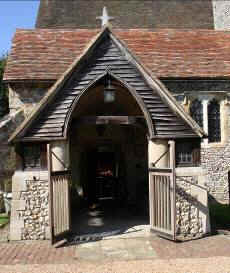 According to the Domesday Book
(1086 - 87), there was already a Saxon church here at
According to the Domesday Book
(1086 - 87), there was already a Saxon church here at 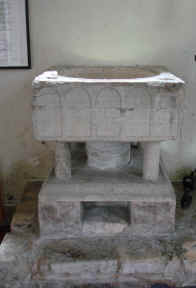 The massive font, on your right as you
enter, is also
The massive font, on your right as you
enter, is also
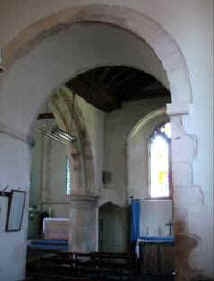 Changes were made in the 13th
century. At that time what is now the chancel, with its lancet windows,
plus the small area westwards towards the end of the tower, would have
formed the nave - the main body of the church.
At least, this is what can be deduced from the evidence of the
church in the nearby village
of
Changes were made in the 13th
century. At that time what is now the chancel, with its lancet windows,
plus the small area westwards towards the end of the tower, would have
formed the nave - the main body of the church.
At least, this is what can be deduced from the evidence of the
church in the nearby village
of
A further development took place in the 14th century, when the present nave and the south aisle were added. At the same time the tower base was pierced and supported by an arch to give access to the Lady Chapel. It was probably at this time that the font was moved to its present site.
The John Strete Brass
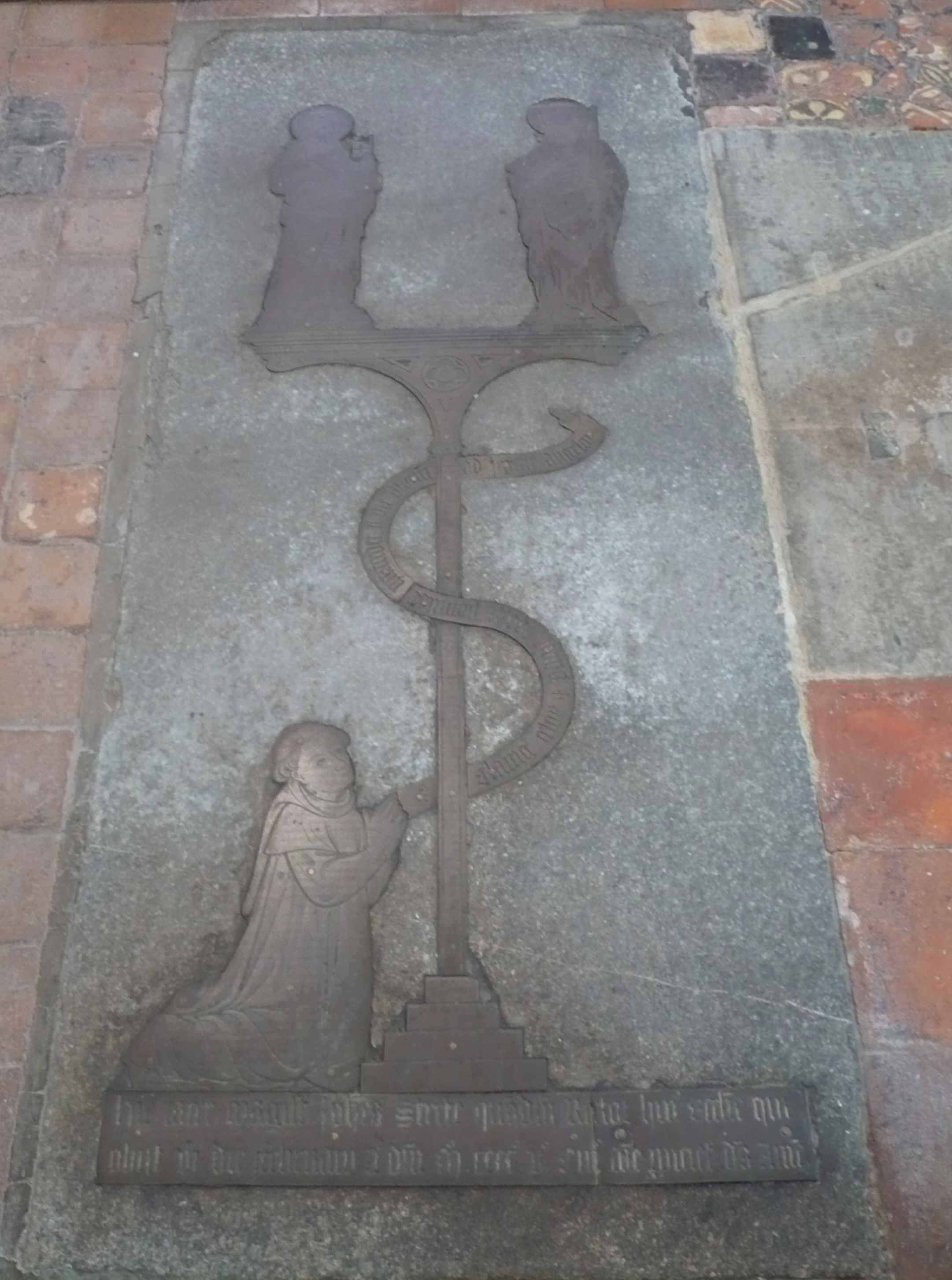 Hanging
on the wall of the Lady Chapel is a brass rubbing.
It was made in memory of Leslie
Long by his son Anthony.
It depicts one of the church’s treasured possessions, the John
Strete ‘Bracket Brass’. One of the most famous complete brasses in the
country, it has considerable artistic merit.
John Strete was once a rector of this parish, who died on 6th
February 1405. He is shown
kneeling, with the patron saints of the church on a bracket behind him.
A Latin prayer entwines the pillar supporting the bracket.
A rough translation is, [Peter,]
keybearer of Heaven, and
Paul, the teacher of the people, intercede for me to the King of Angels
that I may be worthy.
Hanging
on the wall of the Lady Chapel is a brass rubbing.
It was made in memory of Leslie
Long by his son Anthony.
It depicts one of the church’s treasured possessions, the John
Strete ‘Bracket Brass’. One of the most famous complete brasses in the
country, it has considerable artistic merit.
John Strete was once a rector of this parish, who died on 6th
February 1405. He is shown
kneeling, with the patron saints of the church on a bracket behind him.
A Latin prayer entwines the pillar supporting the bracket.
A rough translation is, [Peter,]
keybearer of Heaven, and
Paul, the teacher of the people, intercede for me to the King of Angels
that I may be worthy.
Windows
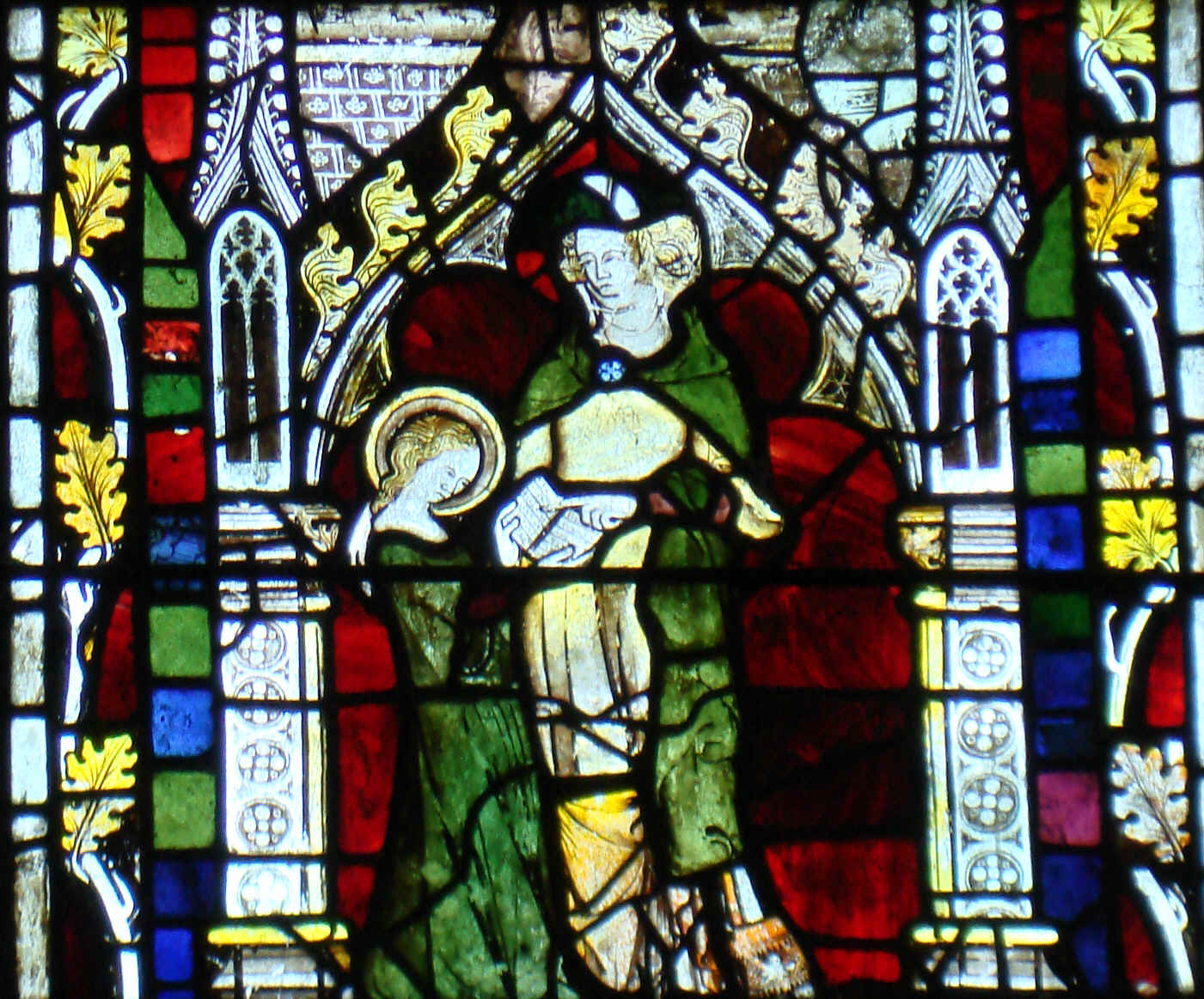 was shattered in
1972 by a disastrous fire: photos of the damage done are on display.
Perhaps inspired by the example of M. Pierre Turpin, a 1935 French
glass painter, and his companion, Mr. N E
Toke who, as visitors, were so
frustrated by the dirt covering the windows that they obtained a bucket of
water and proceeded to clean them, the church paid £6,500 to the
Cathedral glaziers to clean and restore the fragments.
We are now privileged to see some of the finest specimens of glass
painting in the 14th century; there are certainly no finer
examples of painting from that century in Kent.
was shattered in
1972 by a disastrous fire: photos of the damage done are on display.
Perhaps inspired by the example of M. Pierre Turpin, a 1935 French
glass painter, and his companion, Mr. N E
Toke who, as visitors, were so
frustrated by the dirt covering the windows that they obtained a bucket of
water and proceeded to clean them, the church paid £6,500 to the
Cathedral glaziers to clean and restore the fragments.
We are now privileged to see some of the finest specimens of glass
painting in the 14th century; there are certainly no finer
examples of painting from that century in Kent.
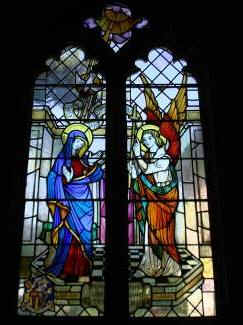 The
stained glass window (left) in the Lady Chapel is modern.
It is dedicated to the memory of Cecil and Dorothy Neame of
The
stained glass window (left) in the Lady Chapel is modern.
It is dedicated to the memory of Cecil and Dorothy Neame of
Memorials
Most of the memorials in the
church are to the Hardres family of
On the north side of the altar is
the memorial to the Rev Davis Jones and his first wife Roberta. Compare
his touching protestation - Dear
wife blest saint since thou art gone before, I’ll love heaven better to
see thee once more – with the fact that just nine months after her
death he married the only sister of the last Sir William Hardres.
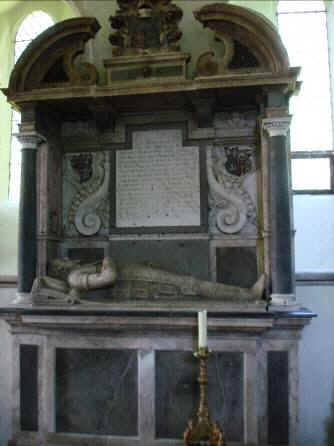 Further
west on the same side of the sanctuary is the fine memorial to Sir Thomas
Hamon (left), who died in 1684. That
above the archway leading from the nave into the tower is to Richard
Barham, who died in 1795. He
was the father of Thomas
Ingoldsby, author of The
Ingoldsby Legends. On the
north side of the nave is the marble memorial to Mrs Elizabeth
Denward.
It lists all her charitable activities – she built a school and
repaired both this and
Further
west on the same side of the sanctuary is the fine memorial to Sir Thomas
Hamon (left), who died in 1684. That
above the archway leading from the nave into the tower is to Richard
Barham, who died in 1795. He
was the father of Thomas
Ingoldsby, author of The
Ingoldsby Legends. On the
north side of the nave is the marble memorial to Mrs Elizabeth
Denward.
It lists all her charitable activities – she built a school and
repaired both this and
Church
Plate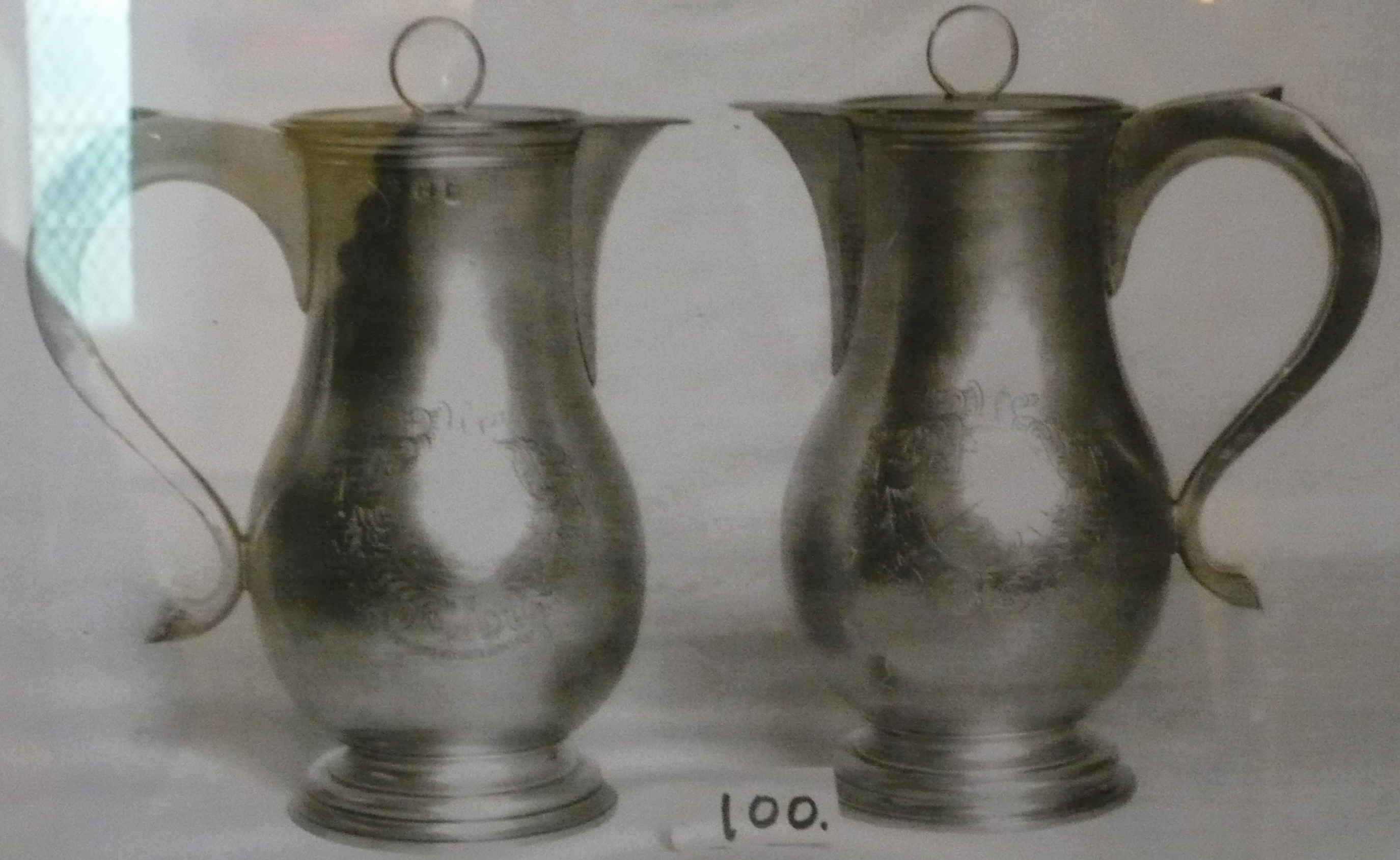
These days it is unfortunately not feasible to display the silver patens (plates which hold the consecrated bread during communion), flagon and chalice (a standing cup used to hold sacramental wine during Holy Communion) which date from the eighteenth century. They are in the safekeeping of the Cathedral Treasury and on display there. The photograph on the right is found in the lady chapel and shows what the flagons are like.
Bells
The tenor bell, made by William Daw of London in the late 14th Century, weighs approximately 433 kg. A rough translation of its Latin inscription is, Called Katherine, I am the resounding rose of the world. The second, weighing approximately 293kg was made by Joseph Hatch of Ulcombe in 1609. The treble made by Samuel Knight of London in 1727, weighs approximately 191 kg.
The Organ
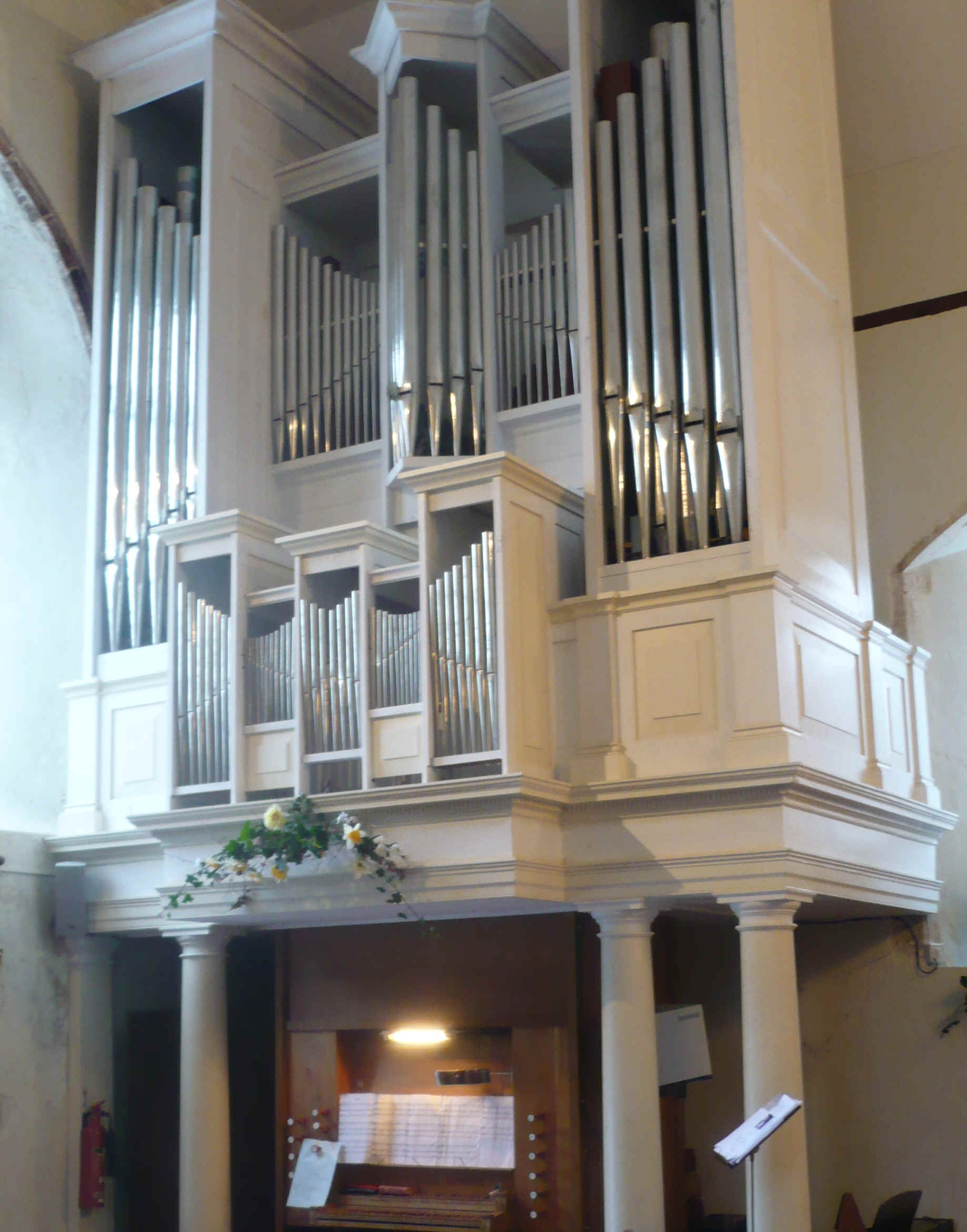 The
church organ is located in the nave near to the west window.
The
church organ is located in the nave near to the west window.
Judith Cutler 2007 (based on research by Rev W H J Burt, Rector 1979-1984)